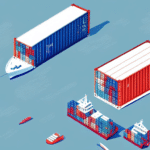Understanding CPT (Carriage Paid To) in International Shipping
If you’re involved in international trade, you’ve likely come across the term CPT (Carriage Paid To). CPT is an international trade term used to describe a specific shipping agreement between buyers and sellers. Understanding CPT is essential to prevent misunderstandings and ensure successful transactions. In this article, we’ll provide an in-depth analysis of CPT in international shipping, supported by relevant data and authoritative sources.
The Definition and Purpose of CPT in International Shipping
CPT (Carriage Paid To) is a shipping agreement under the Incoterms® 2020 rules, which defines the obligations of buyers and sellers in the transportation of goods. Under CPT, the seller is responsible for the cost and arrangement of transporting goods to an agreed-upon destination. The seller’s responsibility is fulfilled once the goods are handed over to the first carrier.
Using CPT provides clarity in cost allocation and responsibilities, reducing the risk of disputes. According to the International Chamber of Commerce, CPT can be a cost-effective option as sellers can negotiate better rates with carriers due to higher shipping volumes, benefiting both parties.
The Key Components of CPT: Carriage, Freight Charges, and Destination
There are three key components to CPT: carriage, freight charges, and destination. Let’s examine each in detail.
Carriage
Carriage refers to the physical transportation of goods from the seller to the buyer’s destination. Under CPT, the seller arranges and pays for transportation, typically through a freight carrier or logistics company. Once the goods are with the carrier, responsibility shifts from the seller to the carrier.
Freight Charges
Freight charges are the costs associated with transporting the goods. In a CPT agreement, the seller bears all costs related to shipping the goods to the specified destination.
Destination
Destination is the final delivery location of the goods. The seller ensures that goods are transported to this agreed destination. Upon arrival, the buyer assumes responsibility for the goods.
Insurance
While insurance is optional under CPT, it is highly recommended. Sellers may choose to purchase insurance to protect the goods during transit, covering any loss or damage that may occur.
Documentation
Documentation is crucial in CPT agreements. The seller must provide all necessary documents, such as bills of lading and commercial invoices, to facilitate cross-border transportation and customs clearance. Buyers are responsible for obtaining any required import licenses or permits.
The Difference Between CPT and Other International Trade Terms
CPT is one of many Incoterms® used to define shipping obligations. Here’s how CPT compares to other common terms:
- CFR (Cost and Freight): Similar to CPT, CFR requires the seller to pay transportation costs. However, under CFR, the seller’s responsibility ends once goods are loaded onto the shipping vessel, whereas CPT extends to the agreed destination.
- CIF (Cost, Insurance, and Freight): CIF includes insurance costs in addition to transportation, making it more comprehensive than CPT.
- FOB (Free On Board): Under FOB, the seller is responsible only until goods are loaded onto the ship, after which the buyer assumes responsibility.
Choosing the appropriate Incoterm is crucial as it impacts cost distribution and responsibility. For more details, refer to the Incoterms® 2020 rules.
The Importance of Proper Use of CPT in International Trade
Properly using CPT ensures smooth transactions and minimizes risks. Key considerations include:
- Clearly understanding each party’s obligations under CPT.
- Agreeing on the correct destination for shipment.
- Selecting a reputable and reliable freight carrier.
- Determining appropriate insurance coverage.
Additionally, accurate and complete documentation is vital. Incomplete or incorrect paperwork can lead to delays, fines, or even seizure of goods. Evaluating potential risks, such as damage or loss during transit, and having strategies to mitigate them, ensures successful and profitable transactions.
How to Determine the Appropriate Insurance Coverage for CPT Shipments
While insurance is optional under CPT, determining the right coverage is crucial. Sellers should assess the value of the goods and the risks involved in the transportation route. According to ShipScience, it’s advisable to secure insurance that fully covers the shipment’s value to protect both parties from potential losses.
Common Risks and Liabilities Involved with CPT Shipping
Despite its advantages, CPT shipping carries several risks:
- Damage to goods during transportation.
- Loss or theft of goods in transit.
- Delays in shipment or delivery schedules.
- Non-compliance with international customs regulations.
Understanding the Role of Freight Forwarders in CPT Shipping
Freight forwarders are pivotal in managing CPT shipping arrangements. Their roles include:
- Coordinating transportation services efficiently.
- Ensuring compliance with international customs policies.
- Arranging appropriate insurance coverage for shipments.
- Managing all necessary shipping documentation.
- Providing expert advice on best practices for international shipping.
Leveraging the expertise of freight forwarders can significantly enhance the efficiency and reliability of CPT shipments.
The Benefits and Challenges of Using CPT in International Trade Transactions
Benefits of Using CPT
- Clarity and Simplicity: Clearly defines the responsibilities of both buyer and seller.
- Cost Efficiency: Sellers can negotiate better shipping rates, reducing overall costs.
- Reduced Risk of Disputes: Detailed obligations minimize misunderstandings.
- Insurance Protection: Ensures goods are insured during transit, safeguarding both parties.
Challenges of Using CPT
- Increased Seller Responsibility: Sellers bear significant responsibility for arranging and paying for transportation.
- Limited Buyer Control: Buyers may have less influence over the shipping process and carrier selection.
- Potential Risks: Risks such as damage or loss of goods remain despite insurance.
A Step-by-Step Guide to Implementing CPT in Your International Shipping Strategy
Implementing CPT effectively involves several steps:
- Review and understand the obligations of both parties under CPT.
- Agree upon the destination point for the shipment.
- Select a reputable and reliable freight carrier.
- Determine and secure appropriate insurance coverage.
- Prepare and obtain all necessary shipping documentation.
- Ensure compliance with all relevant customs policies and regulations.
- Arrange for timely payment of shipping costs.
- Monitor the shipment throughout transportation to address any issues promptly.
- Confirm the arrival and condition of goods at the destination.
Practical Examples of CPT in Action
Here are practical scenarios illustrating the use of CPT in international trade:
- An electronics manufacturer in China sells a batch of televisions to a retailer in the United States. Under CPT, the manufacturer arranges and pays for transportation from China to the retailer’s warehouse in the US.
- An agricultural producer in Brazil exports a shipment of coffee beans to a distributor in Germany. The producer handles and pays for the transportation from Brazil to Germany under a CPT agreement.
Best Practices for Negotiating Favorable CPT Terms with Your Suppliers or Buyers
When negotiating CPT terms, consider the following best practices:
- Clearly define each party’s obligations to avoid ambiguities.
- Agree on a precise and feasible destination for the shipment.
- Choose a freight carrier with a strong reputation for reliability and safety.
- Ensure comprehensive insurance coverage matches the shipment’s value.
- Include any applicable taxes, duties, or additional costs in the shipping budget.
- Approach negotiations with a willingness to compromise to reach mutually beneficial terms.
Potential Pitfalls to Avoid When Using CPT in International Shipping
To ensure smooth CPT transactions, avoid these common pitfalls:
- Assuming Insurance: Do not assume shipments are insured; always verify coverage.
- Unclear Destination: Ensure the shipment destination is clearly agreed upon.
- Unreliable Carriers: Avoid carriers with poor track records.
- Poor Shipment Monitoring: Regularly monitor shipments to address issues promptly.
Future Trends and Developments in CPT and International Shipping
The landscape of CPT and international shipping is continually evolving. Key trends to watch include:
- Technological Innovations: The rise of electric and autonomous vehicles may revolutionize shipping logistics.
- Impact of Global Events: Events like the COVID-19 pandemic continue to influence shipping practices and regulations.
- Data and Analytics: Increasing use of data analytics to optimize shipping routes and improve efficiency.
- Sustainability Initiatives: Growing emphasis on sustainable shipping practices to reduce environmental impact.
Conclusion: Why Understanding CPT is Essential for Success in Global Trade
CPT is a fundamental international trade term that delineates the responsibilities of buyers and sellers in the shipping process. Mastering CPT ensures that shipments are efficiently arranged, appropriately insured, and delivered to the correct destination. By leveraging CPT effectively, businesses can streamline their shipping operations, reduce costs, and minimize the risk of disputes. Staying informed about the latest trends and best practices in CPT and international shipping is vital for maintaining a competitive edge in global trade.






















